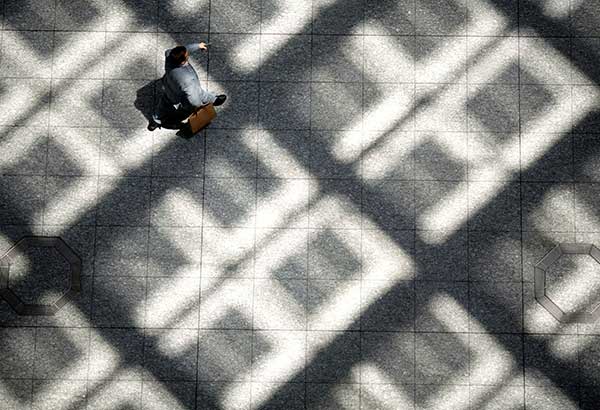Extreme weather monitoring gets boost from Japan

In this file photo, a businessman walks on the floor where lies the shadow cast by the glass roof of a building in Tokyo. The Japan Meteorological Agency has announced that th e rainy season in Kanto area appeared to be over in August. AP
MANILA, Philippines — The Department of Science and Technology (DOST) will get another ground receiving station to back up its existing Philippine Earth Data Resource Observation (PEDRO) station at the Advanced Science and Technology Institute (ASTI) in Quezon City.
Alvin Retamar of ASTI said the ground station will be provided by the Japanese government through the Japan International Cooperation Agency (JICA), which has allotted a Y500-million grant for the development of extreme weather monitoring and information sharing system for the Philippines.
The program seeks to enable the DOST to use its Diwata-1 microsatellite as well as other weather monitoring sensors to develop a lightning detection and extreme weather monitoring system over the Philippine area of responsibility.
Under the program, Retamar said Japan will be providing high-tech equipment such as weather detection sensors and another ground receiving station.
“They will be building for us another ground station for the microsatellite, aside from our PEDRO, for redundancy,” he said. “We need redundancy for the ground station... It’s good if you have another ground station somewhere to receive images continuously so operations are not disrupted.”
The DOST earlier set up the PEDRO station to enable the institute to receive satellite images taken daily by the Philippines’ first microsatellite, Diwata-1, launched successfully into orbit last year.
JICA said the project aims to establish the first next generation extreme weather monitoring system in the Philippines and help the country further improve its disaster resiliency.
“The flooding in Thailand in 2011, Tropical Storm Ondoy in the Philippines in 2009, and then Typhoon Yolanda in 2013 showed us the human toll, economic losses, and supply chain risks that extreme weather entails,” said JICA senior representative Ayumu Ohshima.
“JICA welcomes this partnership of Filipino and Japanese scientists to enhance disaster information sharing and research,” Ohshima said.
Scientists from ASTI and Japan’s Hokkaido University will establish a lightning detection network using automatic lightning and weather monitoring system as well as Diwata-1.
Also part of the project are the Office of Civil Defense (OCD), Metropolitan Manila Development Authority (MMDA) and University of the Philippines Diliman.
The DOST had tapped the technical assistance of Hokkaido University and Tohoku University, also of Japan, for its successful effort to develop the country’s first microsatellite.
“This lightning detection network will be the first that can estimate both location and energy of lightning in the Philippines and could be a model for other Asian countries to help predict intensity of severe weather events and mitigate damage,” said professor Mitsuteru Sato of the Faculty of Science in Hokkaido University.
Lightning activities, according to Sato, are closely related to thunderstorm intensity and severe weather such as typhoons, tornadoes and torrential rainfall.
- Latest




























